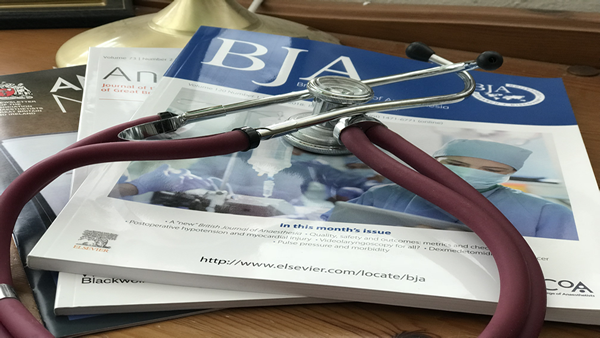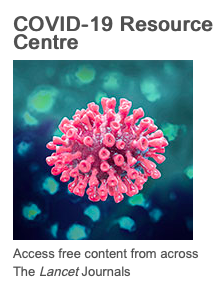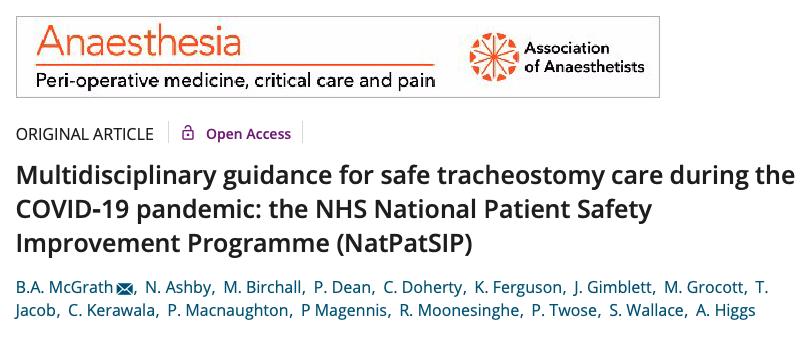
First up, from the Lancet Respiratory Medicine is the international consensus guidance on multidisciplinary tracheostomy management in the COVID-19 era. See the link here:
https://www.thelancet.com/action/showPdf?pii=S2213-2600%2820%2930230-7

Then the UK-specific detail from the journal Anaesthesia, bringing together all of the key stakeholders to highlight the National Patient Safety Improvement Program. Link here https://onlinelibrary.wiley.com/doi/10.1111/anae.15120

Literature roundup from 22/6/20
1. J Surg Res. 2020 Jun 18;255:216-223. doi: 10.1016/j.jss.2020.05.061. [Epub ahead
of print]
Long-Term Outcomes After Pediatric Tracheostomy-Candidates for and Timing of
Decannulation.
Sekioka A(1), Fukumoto K(2), Miyake H(2), Nakaya K(2), Nomura A(2), Yamada S(2),
Kanai R(2), Urushihara N(2).
Author information:
(1)Department of Pediatric Surgery, Shizuoka Children's Hospital, Shizuoka,
Japan. Electronic address: akinori-sekioka@i.shizuoka-pho.jp.
(2)Department of Pediatric Surgery, Shizuoka Children's Hospital, Shizuoka,
Japan.
BACKGROUND: Although pediatric tracheostomy has been a widely performed,
life-saving procedure, its long-term outcomes have remained unclear. This study
aimed to review outcomes after tracheostomy at a Japanese tertiary hospital and
clarify candidates for and timing of decannulation.
MATERIALS AND METHODS: Hospital records of critically ill children who underwent
tracheostomy from 2001 to 2014 were retrospectively reviewed, subsequently
analyzing outcomes according to demographics, complications, and decannulation.
After excluding those who were lost to follow-up or had irreversible
neuromuscular impairment, the remaining patients were divided into the
decannulation (D group) and nondecannulation (ND group) groups and compared.
RESULTS: In total, 184 patients who underwent tracheostomy were analyzed (median
age at operation: 0.5 y). The major indication for tracheostomy was irreversible
neuromuscular impairment (46%). Surgery-related and overall mortality rates were
1% and 25%, respectively, while the successful decannulation rate was 21%. No
significant difference in surgical indications or comorbidities was observed
between the D (n = 39) and ND (n = 50) groups, except for infection (7 in D group
versus 0 in ND group; P = 0.002) and chromosome-gene disorder (15% versus 34%;
P = 0.04). The ND group had a significantly higher mortality rate than the D
group (46% versus 3%; P < 0.0001). The median time to decannulation was
3.6 years, while that for infection was 0.7 y.
CONCLUSIONS: Patients who underwent tracheostomy at our institution due to
temporary infections achieved more successful and earlier decannulation compared
to other indications. Chromosome-gene disorder as a comorbidity can negatively
affect decannulation.
Copyright © 2020 Elsevier Inc. All rights reserved.
DOI: 10.1016/j.jss.2020.05.061
PMID: 32563762
2. Eur Arch Otorhinolaryngol. 2020 Jun 17. doi: 10.1007/s00405-020-06126-0. [Epub
ahead of print]
Tracheostomy care and decannulation during the COVID-19 pandemic. A
multidisciplinary clinical practice guideline.
Rovira A(1), Dawson D(2), Walker A(3), Tornari C(4), Dinham A(5), Foden N(4),
Surda P(6), Archer S(7), Lonsdale D(8)(9), Ball J(8), Ofo E(4), Karagama Y(6),
Odutoye T(4), Little S(4), Simo R(6), Arora A(6).
Author information:
(1)Department of Otorhinolaryngology Head and Neck Surgery, St George's Hospital
NHS Foundation Trust, London, UK. aleix.rovira@nhs.net.
(2)Department of Critical Care, St George's Hospital NHS Foundation Trust,
London, UK.
(3)Department of Otorhinolaryngology Head and Neck Surgery, University Hospital
Lewisham, London, UK.
(4)Department of Otorhinolaryngology Head and Neck Surgery, St George's Hospital
NHS Foundation Trust, London, UK.
(5)Department of Physiotherapy, Guy's and St Thomas Hospital NHS Foundation
Trust, London, UK.
(6)Department of Otorhinolayngology Head and Neck Surgery, Guy's and St Thomas
Hospital NHS Foundation Trust, London, UK.
(7)Speech and Language Therapy Department, Guy's and St Thomas' NHS Foundation
Trust, London, UK.
(8)Critical Care Unit, St George's Hospital NHS Foundation Trust, London, UK.
(9)St George's University of London, London, UK.
PURPOSE: Traditional critical care dogma regarding the benefits of early
tracheostomy during invasive ventilation has had to be revisited due to the risk
of COVID-19 to patients and healthcare staff. Standard practises that have
evolved to minimise the risks associated with tracheostomy must be
comprehensively reviewed in light of the numerous potential episodes for aerosol
generating procedures. We meet the urgent need for safe practise standards by
presenting the experience of two major London teaching hospitals, and synthesise
our findings into an evidence-based guideline for multidisciplinary care of the
tracheostomy patient.
METHODS: This is a narrative review presenting the extensive experience of over
120 patients with tracheostomy, with a pragmatic analysis of currently available
evidence for safe tracheostomy care in COVID-19 patients.
RESULTS: Tracheostomy care involves many potentially aerosol generating
procedures which may pose a risk of viral transmission to staff and patients. We
make a series of recommendations to ameliorate this risk through infection
control strategies, equipment modification, and individualised decannulation
protocols. In addition, we discuss the multidisciplinary collaboration that is
absolutely fundamental to safe and effective practise.
CONCLUSION: COVID-19 requires a radical rethink of many tenets of tracheostomy
care, and controversy continues to exist regarding the optimal techniques to
minimise risk to patients and healthcare workers. Safe practise requires a
coordinated multidisciplinary team approach to infection control, weaning and
decannulation, with integrated processes for continuous prospective data
collection and audit.
DOI: 10.1007/s00405-020-06126-0
PMCID: PMC7299456
PMID: 32556788
3. Eur Arch Otorhinolaryngol. 2020 Jun 17. doi: 10.1007/s00405-020-06134-0. [Epub
ahead of print]
Reply to "Indications and timing for tracheostomy in patients with SARS
CoV2-related" by Ferri et al.
Mattioli F(1), Marudi A(2), Ghirelli M(1), Molteni G(3), Sgarbi N(2), Valerini
S(1), Girardis M(2), Presutti L(1), Fermi M(4).
Author information:
(1)Otorhinolaryngology-Head and Neck Surgery Department, University Hospital of
Modena, Via del Pozzo 71, 41100, Modena, Italy.
(2)Department of Anesthesiology, University Hospital of Modena, Via del Pozzo 71,
41100, Modena, Italy.
(3)Otorhinolaryngology-Head and Neck Surgery Department, University Hospital of
Verona, Piazzale Aristide Stefani, 41100, Verona, Italy.
(4)Otorhinolaryngology-Head and Neck Surgery Department, University Hospital of
Modena, Via del Pozzo 71, 41100, Modena, Italy. matteo.fermi.med@gmail.com.
DOI: 10.1007/s00405-020-06134-0
PMCID: PMC7297929
PMID: 32556782
4. J Voice. 2020 Jun 14. pii: S0892-1997(20)30153-3. doi:
10.1016/j.jvoice.2020.04.025. [Epub ahead of print]
Substitution Voice Rehabilitation After Open Partial Horizontal Laryngectomy
Through the Proprioceptive Elastic Method (PROEL): A Preliminary Study.
Fantini M(1), Gallia M(2), Borrelli G(3), Pizzorni N(4), Ricci Maccarini A(5),
Borragan Torre A(6), Schindler A(4), Succo G(7), Crosetti E(2).
Author information:
(1)Head and Neck Oncology Service, Candiolo Cancer Institute, FPO IRCCS,
Candiolo, Italy. Electronic address: marcofantini8811@hotmail.it.
(2)Head and Neck Oncology Service, Candiolo Cancer Institute, FPO IRCCS,
Candiolo, Italy.
(3)Otorhinolaryngology Service, San Luigi Gonzaga Hospital, University of Turin,
Turin, Italy.
(4)Department of Biomedical and Clinical Sciences "L. Sacco", University of
Milan, Milan, Italy.
(5)Otorhinolaryngology Service, Bufalini Hospital, Cesena, Italy.
(6)Centro de Foniatria y Logopedia, Santander, Spain.
(7)Head and Neck Oncology Service, Candiolo Cancer Institute, FPO IRCCS,
Candiolo, Italy; Oncology Department, University of Turin, Turin, Italy.
OBJECTIVE: The aim was to investigate the efficacy of the Proprioceptive Elastic
Method (PROEL) in the rehabilitation of the substitution voice after open partial
horizontal laryngectomy (OPHL).
STUDY DESIGN: Prospective outcome study.
METHODS: Fifteen patients surgically treated by OPHL type II or type III for
laryngeal cancer were recruited (experimental group). Each patient underwent a
specific program of voice rehabilitation based on the PROEL method with the same
speech and language pathologist. Acoustic-aerodynamic analysis: maximum phonation
time (MPT); spectrographic classification (Titze's modified classification),
perceptual analysis (INFVo rating scale) and self-assessments (SECEL
questionnaire) were performed before the treatment (T0), after 3 months of
rehabilitation (T1), and at the end of the 6-month rehabilitation program (T2). A
control sample of other 15 patients who underwent OPHL type II or type III and
who underwent a standard perioperative rehabilitation was randomly extracted from
an historical database and compared to the experimental group.
RESULTS: Significative voice improvements between T0-T1 and T2 were found for
acoustic, aerodynamic, perceptual, and self-assessments analysis in the
experimental group. Significative differences were found between the experimental
group at T2 and the control sample for aerodynamic, self-assessment, and
perceptual analysis.
CONCLUSIONS: The results of the present study support PROEL method as an
effective approach for substitution voice rehabilitation after OPHL type II and
III. Randomized controlled trials on larger groups of patients are needed in
future in order to compare PROEL with other rehabilitative approaches.
Copyright © 2020 The Voice Foundation. Published by Elsevier Inc. All rights
reserved.
DOI: 10.1016/j.jvoice.2020.04.025
PMID: 32553498
5. Minerva Anestesiol. 2020 Jun 17. doi: 10.23736/S0375-9393.20.14878-8. [Epub ahead
of print]
Above cuff vocalisation (ACV): an additional benefit of subglottic suction
tracheostomy tubes.
Mcgrath BA(1).
Author information:
(1)Anaesthesia & Intensive Care Medicine, Manchester University NHS
Foundation Trust, Wythenshawe Hospital, Manchester, UK -
brendan.mcgrath@manchester.ac.uk.
DOI: 10.23736/S0375-9393.20.14878-8
PMID: 32549550
6. Front Physiol. 2020 May 29;11:477. doi: 10.3389/fphys.2020.00477. eCollection
2020.
Impact of Tussigenic Stimuli on Perceived Upper Airway Sensation and Motor Cough
Response Following Total Laryngectomy.
Fullerton A(1), Mou Y(2), Silver N(3), Chheda N(3), Bolser DC(4), Wheeler-Hegland
K(2).
Author information:
(1)Department of Communication Sciences and Disorders, Brooks Rehabilitation
College of Healthcare Science, Jacksonville University, Jacksonville, FL, United
States.
(2)Laboratory of Upper Airway Dysfunction, Department of Speech, Language and
Hearing Sciences, University of Florida, Gainesville, FL, United States.
(3)Division of Head and Neck Surgery, Laboratory of Head and Neck Cancer
Translational Science, Department of Otolaryngology, University of Florida,
Gainesville, FL, United States.
(4)Laboratory of Physiology and Pharmacology of Cough and Airway Protection,
Department of Physiological Sciences, University of Florida, Gainesville, FL,
United States.
Background: Total laryngectomy (TL) is standard intervention for carcinoma of the
head and neck or, in cases of non-functional larynx, as a result of disease or
radiation exposure. Laryngeal extirpation serves as a unique human model of both
recurrent and superior laryngeal nerve section and offers insight into motor and
sensory aspects of cough: both volitional and in response to tussigenic stimuli.
While motor changes in cough function are expected among those status post-TL due
to postoperative reconstruction of the upper airway, motor cough parameters have
not been well described and sensory aspects of cough are unknown in this
population, which provides insight into a vagal denervation model in humans.
Methods: Data were collected from three groups totaling 80 adults (39 male),
including 25 healthy younger adults (HYA), 27 healthy older adults (HOA), and 28
adults post-TL. Cough was elicited both upon command and in response to nebulized
capsaicin. Outcome measures included urge to cough and cough airflows.
Results: Kruskal-Wallis test showed that two of the three groups differed
significantly by urge to cough χ2(2, N = 244) = 8.974, p = 0.011. Post hoc
analysis showed that post-TL subjects had reduced perceived urge to cough at all
concentrations of capsaicin (p < 0.05). Cough airflows were significantly reduced
for post-TL subjects compared to healthy controls in all metrics except post-peak
phase integral (PPPI) for which HOA and TLs were comparable under both volitional
and capsaicin-induced conditions.
Conclusions: These findings support the hypothesis that both cough airflow and
sensations are significantly reduced in post-TL subjects when compared with HOA.
Interestingly, HOA and post-TL subjects have comparably reduced UTC and cough
airflows when compared to HYA. The only metric of cough airflow for which these
groups differ is the PPPI, which may be a compensatory adaptation for reduced
cough airflows and/or sensation.
Copyright © 2020 Fullerton, Mou, Silver, Chheda, Bolser and Wheeler-Hegland.
DOI: 10.3389/fphys.2020.00477
PMCID: PMC7272598
PMID: 32547408
7. Br J Surg. 2020 Jun 16. doi: 10.1002/bjs.11757. [Epub ahead of print]
Tracheotomy in COVID-19 patients: preliminary experience and technical
refinements.
Pasero D(1)(2), Rizzo D(3), Piras A(3), Floris L(1), Parrilla C(4), Riu F(3),
Terragni P(1)(2), Bussu F(3)(2).
Author information:
(1)Intensive Care Unit, Rome, Italy.
(2)Department of Medical, Surgical and Experimental Sciences, Università di
Sassari, Rome, Italy.
(3)Otolaryngology Division, Azienda Ospedaliero Universitaria Sassari, Rome,
Italy.
(4)Otolaryngology Fondazione Policlinico Universitario Agostino Gemelli, Rome,
Italy.
DOI: 10.1002/bjs.11757
PMID: 32542655
8. Ann Surg. 2020 Jun 11. doi: 10.1097/SLA.0000000000004162. [Epub ahead of print]
Response to Comment on: Tracheotomy in Ventilated Patients with COVID-19.
Chao TN(1), Braslow BM, Martin ND, Chalian AA, Atkins JH, Haas AR, Rassekh CH.
Author information:
(1)The COVID-19 Tracheotomy Task Force, a Working Group of the Airway Safety
Committee of the University of Pennsylvania Health System The COVID-19
Tracheotomy Task Force, a Working Group of the Airway Safety Committee of the
University of Pennsylvania Health System The COVID-19 Tracheotomy Task Force, a
Working Group of the Airway Safety Committee of the University of Pennsylvania
Health System The COVID-19 Tracheotomy Task Force, a Working Group of the Airway
Safety Committee of the University of Pennsylvania Health System The COVID-19
Tracheotomy Task Force, a Working Group of the Airway Safety Committee of the
University of Pennsylvania Health System The COVID-19 Tracheotomy Task Force, a
Working Group of the Airway Safety Committee of the University of Pennsylvania
Health System The COVID-19 Tracheotomy Task Force, a Working Group of the Airway
Safety Committee of the University of Pennsylvania Health System.
DOI: 10.1097/SLA.0000000000004162
PMID: 32541228
9. Ann Surg. 2020 Jun 11. doi: 10.1097/SLA.0000000000004166. [Epub ahead of print]
Outcomes after Tracheostomy in COVID-19 Patients.
Chao TN(1), Harbison SP(2), Braslow BM(2), Hutchinson CT(3), Rajasekaran K(1), Go
BC(4), Paul EA(1), Lambe LD(5), Kearney JJ(1), Chalian AA(1), Cereda MF(6),
Martin ND(2), Haas AR(3), Atkins JH(6), Rassekh CH(1).
Author information:
(1)Department of Otorhinolaryngology - Head and Neck Surgery, University of
Pennsylvania, Philadelphia.
(2)Department of Surgery, University of Pennsylvania, Philadelphia.
(3)Division of Pulmonary, Allergy, and Critical Care, University of Pennsylvania,
Philadelphia.
(4)Perelman School of Medicine, University of Pennsylvania, Philadelphia.
(5)Department of Nursing, University of Pennsylvania, Philadelphia.
(6)Department of Anesthesia and Critical Care, University of Pennsylvania,
Philadelphia.
OBJECTIVE: To determine the outcomes of patients undergoing tracheostomy for
COVID-19 and of healthcare workers performing these procedures.
BACKGROUND: Tracheostomy is often performed for prolonged endotracheal intubation
in critically ill patients. However, in the context of COVID-19, tracheostomy
placement pathways have been altered due to the poor prognosis of intubated
patients as well as the risk of transmission to providers through this highly
aerosolizing procedure.
METHODS: A prospective single-system multi-center observational cohort study was
performed on patients who underwent tracheostomy following acute respiratory
failure secondary to COVID-19.
RESULTS: Of the 53 patients who underwent tracheostomy, the average time from
endotracheal intubation to tracheostomy was 19.7 days ± 6.9 days. The most common
indication for tracheostomy was ARDS, followed by failure to wean ventilation and
post-ECMO decannulation. 30 patients (56.6%) were liberated from the ventilator,
16 (30.2%) have been discharged alive, 7 (13.2%) have been decannulated, and 6
(11.3%) died. The average time from tracheostomy to ventilator liberation was
11.8 days ± 6.9 days (range 2 - 32 days). Both open surgical and percutaneous
dilational tracheostomy techniques were performed utilizing methods to mitigate
aerosols. No healthcare worker transmissions resulted from performing the
procedure.
CONCLUSIONS: Alterations to tracheostomy practices and processes were
successfully instituted. Following these steps, tracheostomy in COVID-19
intubated patients appears safe for both patients and healthcare workers
performing the procedure.
DOI: 10.1097/SLA.0000000000004166
PMID: 32541213
10. Ann Surg. 2020 Jun 11. doi: 10.1097/SLA.0000000000004167. [Epub ahead of print]
Comment on "Tracheotomy in Ventilated Patients with COVID-19".
Garas G(1), Mallick AS, O'Donoghue G.
Author information:
(1)Department of Otorhinolaryngology - Head and Neck Surgery, Nottingham
University Hospitals NHS Trust, Queens Medical Centre Campus, Nottingham, United
Kingdom Department of Otorhinolaryngology - Head and Neck Surgery, Nottingham
University Hospitals NHS Trust, Queens Medical Centre Campus, Nottingham, United
Kingdom Department of Otorhinolaryngology - Head and Neck Surgery, Nottingham
University Hospitals NHS Trust, Queens Medical Centre Campus, Nottingham, United
Kingdom.
DOI: 10.1097/SLA.0000000000004167
PMID: 32541212
11. Ann Thorac Surg. 2020 Jun 12. pii: S0003-4975(20)30907-3. doi:
10.1016/j.athoracsur.2020.05.021. [Epub ahead of print]
Pause Ventilation Tracheostomy.
Canan GÜRSOY(1), Turkey M(2).
Author information:
(1)Division Of Intensive Care Unit, Department of Anesthesiology and Reanimation,
Muğla Sıtkı Koçman University Training and Research Hospital.
(2)VURAL Gökhan, GÜMÜŞ DEMİRBİLEK Semra, Department of Anesthesiology and
Reanimation, Muğla Sıtkı Koçman University, Muğla, Turkey. Electronic address:
gursoycanan@yahoo.com.
DOI: 10.1016/j.athoracsur.2020.05.021
PMCID: PMC7291975
PMID: 32540441
12. Acad Pediatr. 2020 Jun 12. pii: S1876-2859(20)30243-6. doi:
10.1016/j.acap.2020.06.004. [Epub ahead of print]
Decision Making about Tracheostomy for Children with Medical Complexity:
Caregiver and Healthcare Provider Perspectives.
Gower WA(1), Golden SL(2), King NMP(2), Nageswaran S(3).
Author information:
(1)Department of Pediatrics, Wake Forest School of Medicine; Department of
Pediatrics, University of North Carolina School of Medicine (current
affiliation).
(2)Department of Social Science and Health Policy, Wake Forest University.
(3)Department of Pediatrics, Wake Forest School of Medicine; Department of Social
Science and Health Policy, Wake Forest University. Electronic address:
snageswa@wakhealth.edu.
OBJECTIVE: Caregivers of children with medical complexity (CMC) face decisions
about tracheostomy. The objectives of this paper are to identify facilitators and
barriers to tracheostomy decision-making (TDM) process for CMC.
METHODS: Using phenomenology as its methodologic orientation, this qualitative
study conducted in North Carolina between 2013 and 2015, consists of
semi-structured interviews with 56 caregivers of 41 CMC who received
tracheostomies, and 5 focus groups of 33 healthcare providers (HCP) at a tertiary
care children's hospital involved in TDM for CMC. Participants were asked to
share their experiences and perspectives on the TDM process. Qualitative data
were transcribed, coded, and organized into themes as is consistent with thematic
content analysis.
RESULTS: Five themes were identified. 1) Caregivers perceived decision about
tracheostomy for their children was theirs to make. 2) Strategies that increased
caregivers' active participation in the TDM process facilitated the TDM process.
3) Caregiver emotional stress and lack of understanding about tracheostomy were
barriers. 4) Good HCP communication during the TDM process was valued; poor
communication was a barrier. 5) Collaboration among HCP facilitated TDM,
especially when nurses were involved, whereas fragmentation in care was a
barrier.
CONCLUSIONS: Caregivers take a primary role in the TDM process. Many caregiver
and HCP-level facilitators and barriers for TDM exist. Augmenting the
facilitators and reducing the barriers identified in this study could improve the
TDM process for CMC.
Copyright © 2020 Academic Pediatric Association. Published by Elsevier Inc. All
rights reserved.
DOI: 10.1016/j.acap.2020.06.004
PMID: 32540425
13. Geriatr Gerontol Int. 2020 Jun;20(6):647-648. doi: 10.1111/ggi.13912.
Double lumen endotracheal tube, flexible lightwand and ultrasound to safely carry
out percutaneous tracheostomy.
Vargas M(1), Russo G(2), Servillo G(1).
Author information:
(1)Department of Neurosciences, Reproductive and Odontostomatological Sciences,
University of Naples "Federico II", Naples, Italy.
(2)Otolaryngology Head and Neck Surgery, Monaldi Hospital, Naples, Italy.
DOI: 10.1111/ggi.13912
PMID: 32537870